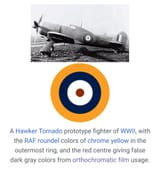Search Results
10/27/2024, 4:37:39 PM
>>458382
Yes and no- in other conditions besides adequate full spectrum lighting, red and black can appear virtually identical.
This was used to great practical effect in photography and related graphic production in the pre-digital days, and is still used in some areas-
>Rubylith® is a red masking film, which is suited for use with orthochromatic films. Rubylith®is "safe" for use with camera speed darkroom films as well as indirect gelatin stencil films and diazo, diazo acrylic, or SBQ sensitized stencil films or emulsions. Rubylith® is primarily used in the camera and plate making operations for offset lithography, flexography, gravure, and screen processes where orthochromatic films and plates are used.
As shown in picrel, certain types of photosensitive emulsions/films "see" saturated reds as black in full spectrum lighting, which is why a red film like Rubylith is as good as opaque for making masks to work with those emulsions.
Yes and no- in other conditions besides adequate full spectrum lighting, red and black can appear virtually identical.
This was used to great practical effect in photography and related graphic production in the pre-digital days, and is still used in some areas-
>Rubylith® is a red masking film, which is suited for use with orthochromatic films. Rubylith®is "safe" for use with camera speed darkroom films as well as indirect gelatin stencil films and diazo, diazo acrylic, or SBQ sensitized stencil films or emulsions. Rubylith® is primarily used in the camera and plate making operations for offset lithography, flexography, gravure, and screen processes where orthochromatic films and plates are used.
As shown in picrel, certain types of photosensitive emulsions/films "see" saturated reds as black in full spectrum lighting, which is why a red film like Rubylith is as good as opaque for making masks to work with those emulsions.
Page 1
